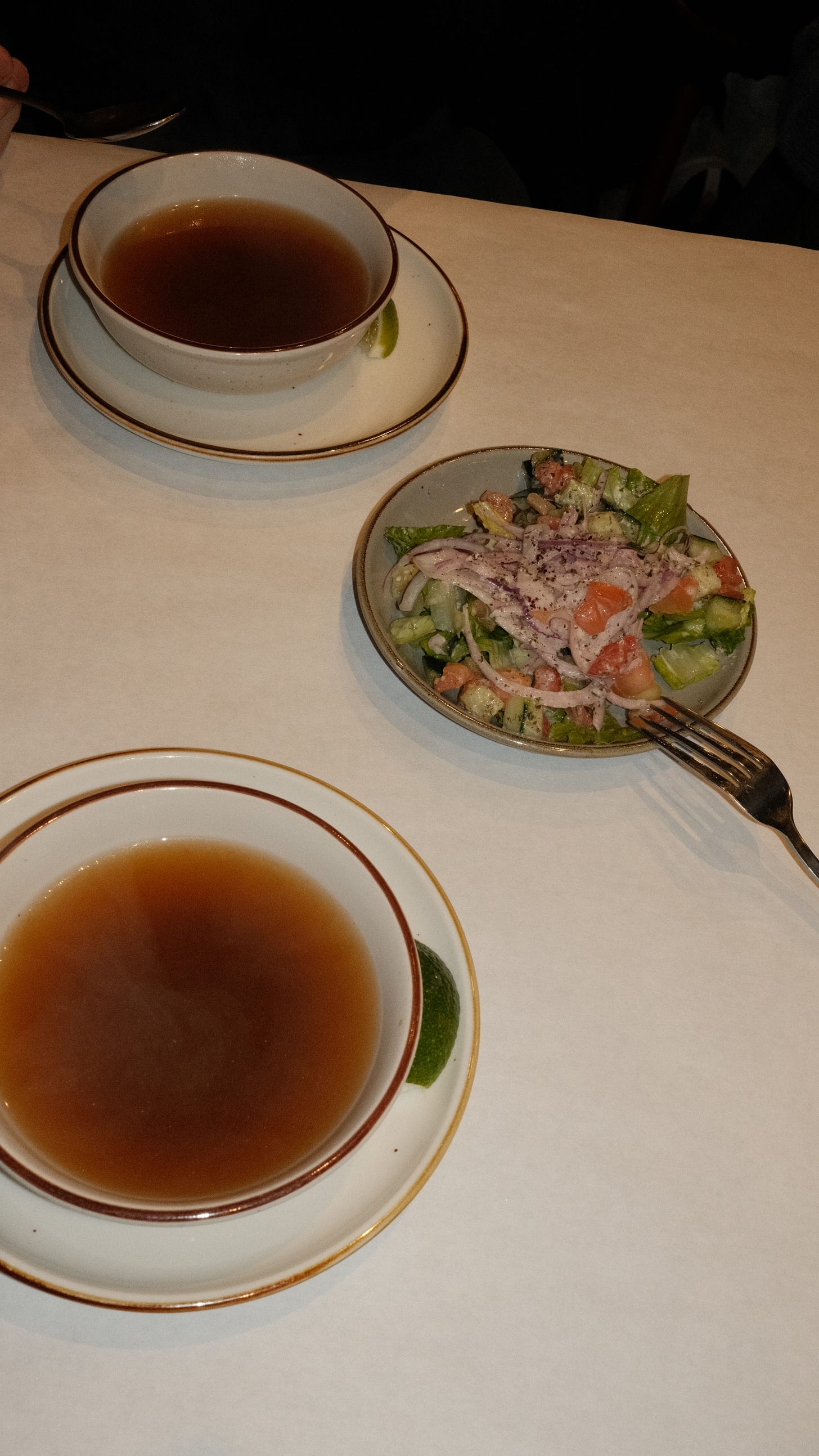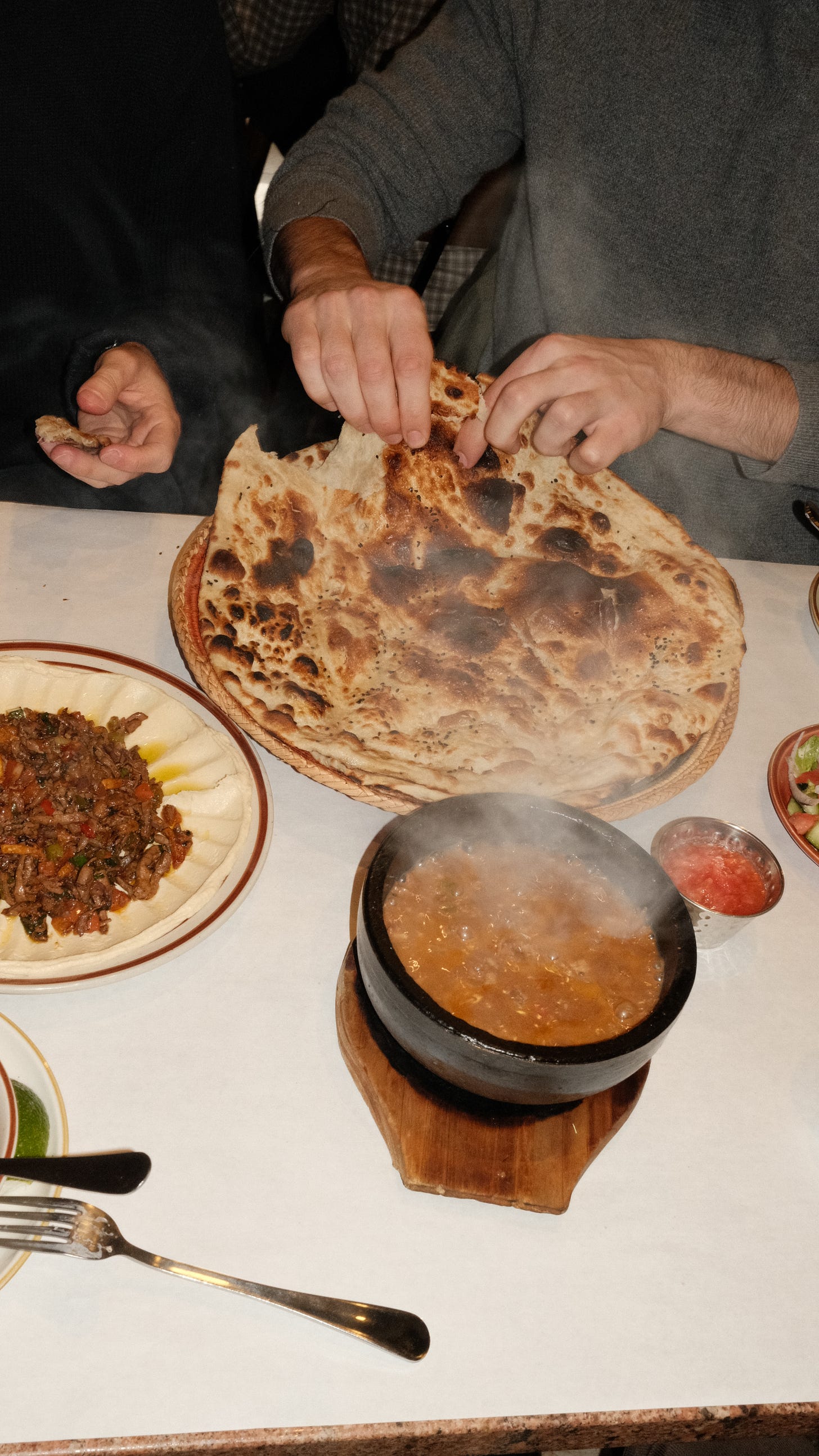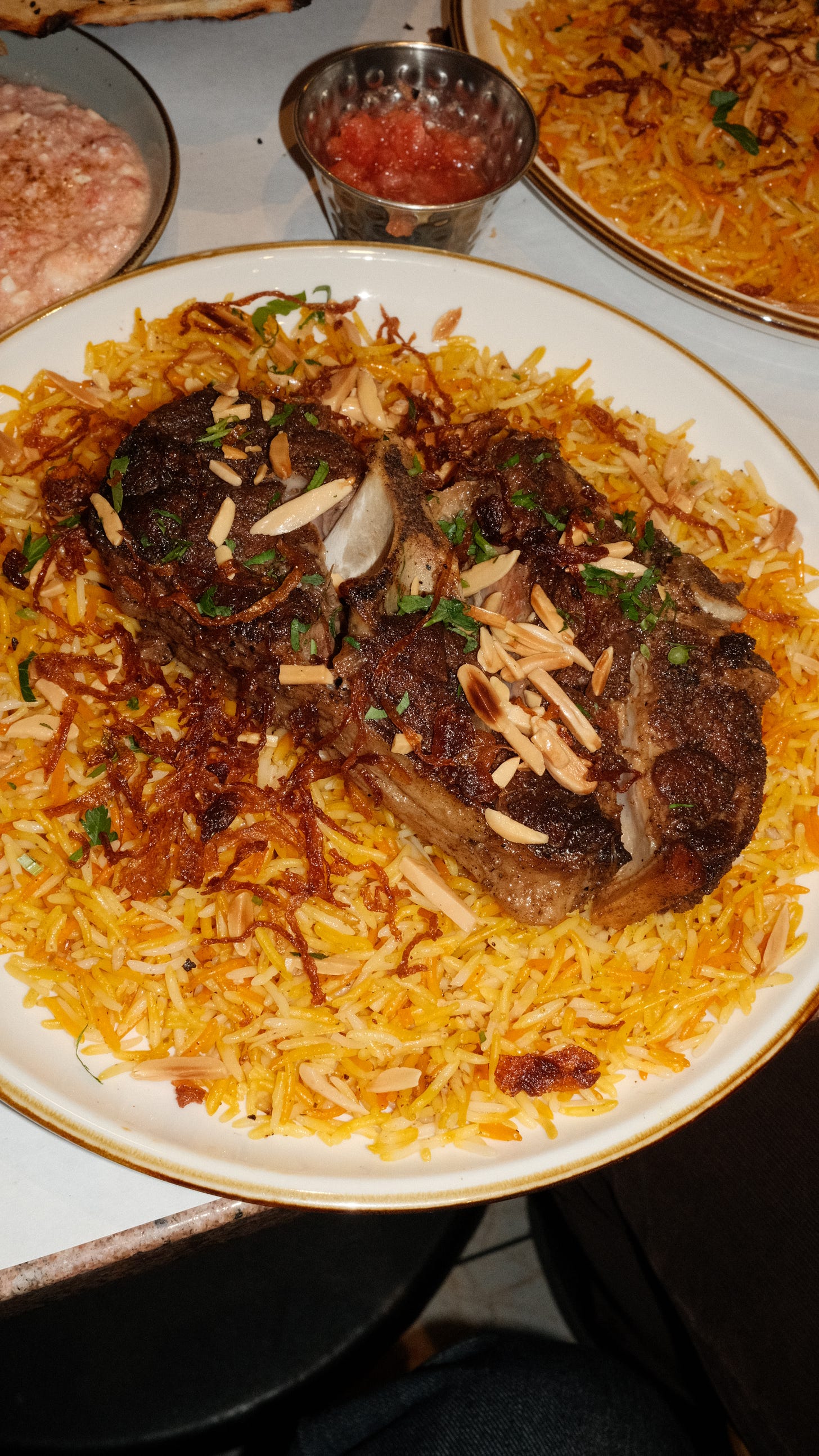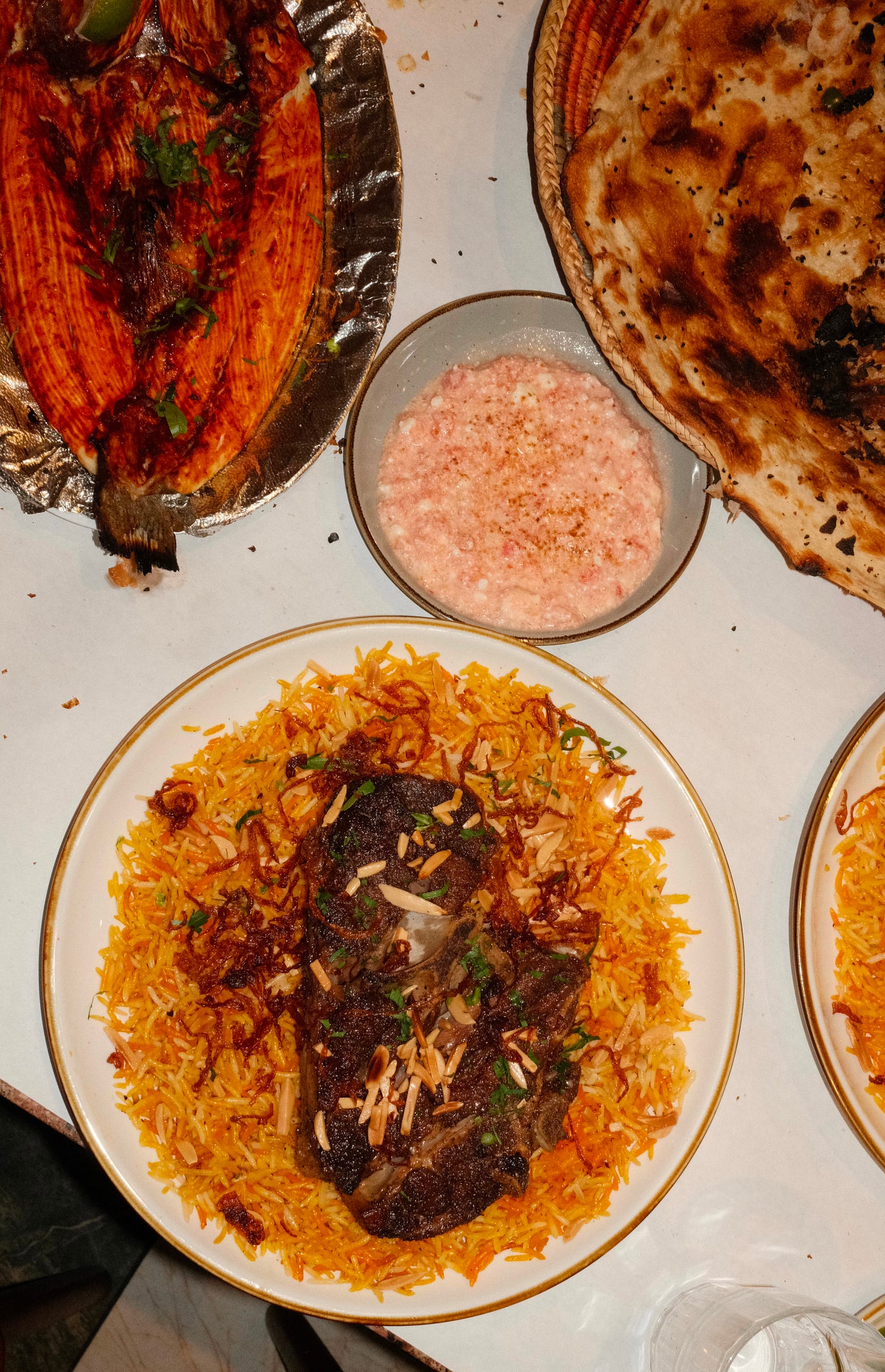Yemenat
The best meal I've had in a long time: Late lunch in Bay Ridge
Since the New Year, I’ve been to Yemen Café on Atlantic Avenue five times. Even if I lived somewhere with far fewer restaurant options, say Tulsa, Oklahoma, I think this would be considered quite a few visits to a single establishment. Yemen Café is a crucial part of my deep winter routine: Flow vinyasa into a meditative yin session, shower off, then hoof it down Atlantic into the warm embrace of Yemen Café. It’s a cathartic release of a Thursday night.
I eat at Yemen Café year-round, but my visit cadence certainly ramps in the winter. I like it because you’re cared for, but mostly left in solitude — it’s a low-touch experience without overwhelming stimulus. You walk in and sit where you’d like. You’re dropped maraq (lamb shank soup) and clay oven bread without needing to speak a word. There’s a dispenser filled with hot spiced tea in the back — help yourself. This self-serve tea dynamic is the closest you’ll find to a frill.
After you place your order — typically sizzling lamb fasah for me — there’s nothing else you have to say or do. Autopilot kicks in, I’ll put on a podcast, and just eat and think. Occasionally, I’ll scan the room and observe what others order: lamb haneeth, baked fish, a chicken dish here and there. But for the most part, it’s an introspective experience. Yemen Café is refreshingly simple — stripped back and serene in a way that’s comforting and repeatable.
Yemen Café was my introduction to Yemeni cuisine. And up until recently, it was also my single data point on the subject. The only reason I haven’t tried more Yemeni food is because it’s a fairly rare commodity. But also, the Yemen Café experience hits every time, so if it ain’t broke…
Last summer, Pete Wells wrote about Yemenat, a Yemeni restaurant in Bay Ridge, Brooklyn. His review, unsurprisingly, caught my attention given my fond feelings for Yemen Café. He sang Yemenat’s praises, talking fondly of both the classic and unique dishes on offer:
As you linger over a wedge of bent assahn, as you drink a cup of sweet, cardamom-scented black tea that you got from an urn in the back of the restaurant, and as you listen to the traditional Yemeni music playing just below the conversational hum, you might think about the palimpsest of cuisines you can find at Yemenat.
Sold. Considering the Yemeni bender I’ve been on amidst the frigid New York temps, it felt like as good a time as ever to venture down and see what Pete was going on about.
Tom, Sam, and Rory came over and we watched Man City rally to score three straight and beat Chelsea. Then we headed to the R train and rode it to Bay Ridge. It’s unfamiliar territory for me. The streets are a little wider, the overall feel a bit calmer and quieter than my usual haunts in Central and North Brooklyn. While the main corridors are bustling and lined with quaint staple businesses, the side streets are sparsely traversed and bordered by humble residential properties. Bay Ridge feels livable in a way that Midtown does not. The buildings are low and the blue sky is always visible over the rooftops. There’s a small-town community feel, but with more than enough commerce to offer, and the big city is just a few subway stops away.
At 2:00 pm, we entered Yemenat. Tom, Rory, and I had fasted all morning. Sam had consumed a bagel earlier but promised he was very hungry. That was part of the deal — if we’re doing this, we’re going all in.
Yemenat offers a few more frills than I’ve grown accustomed to. The space is polished — exposed brick, green-marble flooring, wood-beamed ceilings, and chairs with leather upholstery. But even with nice touches, Yemenat is decidedly casual dining; it’s a chilled-out, come-as-you-are atmosphere. There are TVs in the back running through a slideshow of menu items, and the bi-fold menus show just a little wear. As we settled into the corner table, I’m certain our excitement was outwardly noticeable to onlookers.
We ordered liberally with the assistance of a server eager to talk through her favorite dishes and help us round out the meal. The service at Yemenat is engaged and passionate, but still quite informal. Similar to the approach at Yemen Café, once food lands they mostly leave you to business.
The meal starts in a familiar fashion — with a deeply flavorful, thin-brothed bowl of maraq. But from there, the Yemeni feast was beyond my wildest imagination.
Yemenat’s clay oven-baked rashoosh bread lands in a heaping stack. It’s miraculous. The bread is salty with a slight sweetness. Crisp, with laminated, flaky layers, and a bit of chew — sort of like a compressed croissant or puff pastry. The flatbread is brushed down with ghee and sprinkled with black nigella seeds adding a rich, peppery finish. It’s meant to be ripped, pinched, and dragged through the dishes on the table. So that’s what we did.
The best dish of the afternoon landed early on: kebdah, or spiced lamb liver. Some of you might wince, and I get it. I’m not someone who gets fired up about offals often, but my god, this was special. My biggest fear with liver is texture, but Yemenat’s kebdah is thinly sliced in a way that yields a crisp bite. It’s a worthy upgrade to add a bed of hummus underneath — a smooth, creamy layer that brings together the small bits of liver. Kebdah and hummus wiped with rashoosh is going to be living rent-free in my head for a while.
Two dishes came along with it: sanani kebab — deep-fried ground beef shaped like falafel balls, served over a bright parsley and tomato salad — and beef fahsa, braised, then shredded short ribs in a deep brown, flavorful, spiced stew. Both great dishes, the latter drifts into must-order territory.
Muva fish was a sneaky hit, especially considering that we expected meat to be the unequivocal highlight of the experience. Butterflied branzino was coated in bisbas adeni, a spicy red pepper sauce, and roasted low-and-slow in the clay oven. It’s served with a puréed tomato and feta mixture that almost feels like something you’d encounter on a Greek island. Flaky fish, tangy sauce — it’s lighter and brighter than the rest of the dishes, but with no shortage of flavor.
Lamb haneeth is the most well-known, universally loved Yemeni dish for good reason. When it comes to fatty, braised lamb shoulder, it’s hard to be a hater. Yemenat’s lamb haneeth doesn’t deviate from the traditional preparation — it’s just an outrageously good version of the classic. The lamb is coated in a harmonious blend of spices and then braised until slide-off-the-bone soft and glistening with moisture. It’s flavorful and tender beyond belief. It’s served over a mound of fragrant, orange-tinted, hadrami-style rice. It’s quite honestly the most comforting, nourishing dish I’ve had for as long as I can remember.
The fellas were ready to tap out, but I ordered us dessert. It needed to happen — we had to stick the landing, after all. Yemenat has a sundae with Abu Walad cookie crumble, cardamom gelato, samna caramel, and hawaij candied almonds. It’s sweet, crunchy, with a slight floral, citrusy finish. It was the right call.
There was a real excitement and pride at Yemenat that was contagious. I get the sense they recognize what they’re doing is special — but that sentiment is revealed with the utmost humility. At the risk of sounding dramatic, late lunch at Yemenat is the best meal I’ve had in New York in a long time. It was a soul-warming experience — a table so full of food that you almost felt stifled to choose your next bite.
As I stepped out of Yemenat onto 5th Avenue, the same street that runs north and south to my neck of the woods, it reminded me just how much this city has to offer. When it starts to feel like everything’s been seen, everything’s been done, New York shows yet another layer. There’s magic when you get off the beaten path, that’s for sure. But the next great discovery — the next hidden gem — might not even require you to change streets.
This was a restaurant write-up from Mr. Flood’s Party. Subscribe for free and get Flood’s delivered every week. If you feel inclined, consider becoming a paid subscriber and supporting the creative process.















Sounds like a great food experience!
ok so now i have to try yemeni food... also, photography in this one is fire